This story begins not in Nam Tso but in Lhasa, where we board the Qinghai-Tibet Railway, a high-elevation line also called the Sky Road, for a 21-hour journey from Lhasa to Xining. It’s a dramatic trip that will take us through the heart of Tibet—that magnificent Himalayan state dotted with snow-capped mountains, rolling grasslands and mystic lakes. This is a journey of discovery of Tibet.
The romance of the Sky Train—which runs 3,757 km and connects Lhasa to Beijing—is two-fold: it lies in the stark beauty of the Roof of the World as also in the engineering of the railroad and the train. The railway line is a home-grown effort by Chinese engineers, who took years to innovate, experiment and develop the magnetic wheels that hover over tracks covered with ice and permafrost in Tibet’s deep winters. Inside the compartments, Chinese innovation allows oxygen to be continuously pumped into the compartments through the equivalent of an air-conditioning vent, to spare travellers the discomfort of high altitude sickness.
The train commences in south Tibet, in the capital city of Lhasa at 3,641 metres, hits its highest point of 5,072 metres at Tanggula, and as it moves northward to Xining, loses its altitude at 2,295 metres, finally arriving in Beijing which lies at a mere 31 metres above sea level.
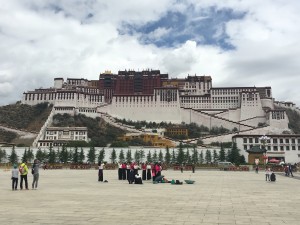
Before embarking on the journey, though, travellers should get a feel for Tibet. Tarry a while in Lhasa, its jewel, where the Potala Palace rises above all structures, white with a red head and a golden crown; where the Jakhong temple, through the prostrations of its worshippers, displays a devotion rarely seen elsewhere in the world; where the Sera monastery sees monks debate in high academic tone on spiritual affairs. Just north of Lhasa and a two-hour drive away, is the holy lake of Yomdrok Tso, a turquoise body of clear water, en route to which the Yarlung Tsangpo river—the source of the Brahmaputra—flows through the mountains.
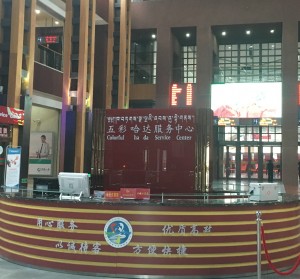
The adventurous are then ready for the train. Be prepared for a modern experience—with Chinese characteristics. The train leaves Lhasa station at 6.30 am. Alas, there are no porters for luggage; Indians used to coolies should travel light.
The station is as clean, well-furnished and large as an airport; it’s easy to be deceived into believing that luxury awaits us on the train. The train itself is a modern tube, sleekly royal purple from the outside—but it is not the Palace on Wheels or the Deccan Odyssey or the Orient Express.
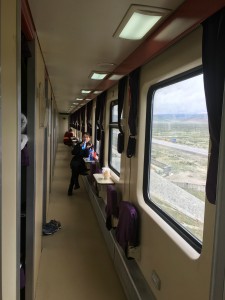
The train has three classes: the usual chair cars for the general public, second-class bogies with compartments of six sleeper bunks for the more monied, and first class, where the compartments each have four bunk beds, with comfortable bedding but not much else.
Bathrooms are for common usage, located at the end of the passage, with Asian-style squatters, and sinks outside, also in the common area. The only concession to the train being in Tibet is the obligatory lota which Tibetans, like Indians, use post-ablution. The bathrooms in the second class bogies are no different from those of the Indian Railways’ second class; beware.

Another disincentive is food. The dining car is devoid of the glamour of the royal bogies of India and Europe—it has a canteen with virtually inedible food in TV-dinner trays. The train and dining car staff know better and bring their own food, bought from the bazaar in Lhasa, which they heat in their kitchen. Eyeing their meal is no help—they won’t share.
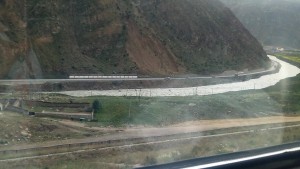
But the joy of the journey is looking outside the big picture-window, and seeing the natural beauty of a land long closed to the public and foreign gaze. We begin our voyage from south to north Tibet, in the bright dawn of a July day, crossing nomad areas with lots of black yak with their silky fur grazing in the grassland. Buddhist prayer flags flutter in the distance, in their five colours—white for the clouds, red for fire, green for the river, yellow for the earth, blue for the Sky. Everything in Tibet is symbolic.
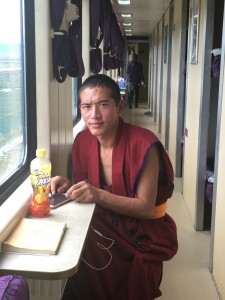
On the train, so much of Tibet is present: an erudite young monk, a cheerful peasant, the beautiful young women. This is not a high-speed train, but we move fast, passing by scores of traditional Tibetan villages, with their Potala Palace-colours—white at the bottom, and red on the top. The devotion of Tibetans to their faith is in their DNA and in their way of living.
The train stops at just six stations. Past the beautiful Nam Tso Lake, we stop at Nagqu where many of the Han Chinese passengers disembark; they are working on government highway and other projects. At Amdo (An Duo), the birthplace of the 14th Dalai Lama, several head-covered Muslims on the train disembark. The Mongols conquered eastern Amdo in 1240, and there are many Muslims in the area, largely now Tibetanised. The girls are delicate and beautiful, with their heads covered with beautifully-embroidered scarves, and diamante or pearl crowns across their foreheads.
At 4 pm we are at the top of the Roof of the World and soon have the first glimpses of snow at the Tanggula mountain pass, the highest point of the journey. Tanggula is the highest station in the world. The landscape is a dazzling white, brighter than the sky. Travellers can’t but notice what a long view the Chinese have: all along the railroad, running parallel to it is the new Tibet highway, electric poles – and cell phone towers.
The highway is always busy, and as night falls, the trucks with their bright lights and heavy loads ply through the unlit roadway, back and forth and back and forth. We are told they are carrying the equipment and materials for the construction that is planned for Tibet’s development.
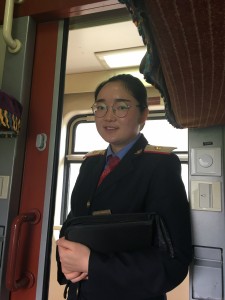
The next morning at around 5.15 am the lady conductor comes to our compartment, she says there has been heavy flooding ahead in Xining and the train cannot proceed. After 45 minutes, and as dawn starts to break, the train finally moves again. There is not much sign of flooding. We pass the northern part of Qinghai Lake, a 4,952-sq km salt water body, as we approach Xining city, the capital of Qinghai province.
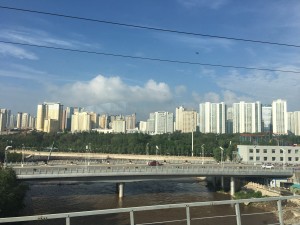
Xining is a large city, full of busy modern streets and high rises and malls and shimmering glass office towers. We have arrived in China, far from the remote and gentle beauty and life of Tibet. But some of Tibet is visible in Xining. And an hour away from Xining is the famous Ta’er Temple and monastery, where the teacher Tsongkhapa founded the Yellow Seat, and where the teacher of the Dalai Lama and the Panchen Lama, were born.
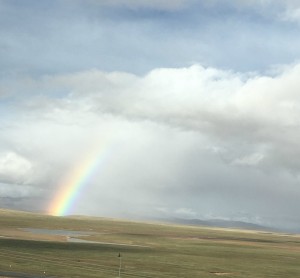
Tibet is special for so many reasons, from the spiritual to the strategic. For India, there is an added dimension. Tibet is the repository of so much of India’s heritage, history and mythology. Its monasteries have preserved Sanskrit texts long lost from India by repeated invasions; it is the storehouse of the live, practiced serenity and mysticism of our spiritual traditions. Its rivers are the source of our rivers, the stories of its lakes hold resonance with ours, its mountains glisten silver and sacred with rich minerals and history embedded in them. Tibet is so familiar, it is almost like being at home.
It is time for Indians to make the journey to all of Tibet, and the train is a good place to start.
Manjeet Kripalani is Executive Director, Gateway House.
This article was originally published by Outlook. Click here to view the original article.


